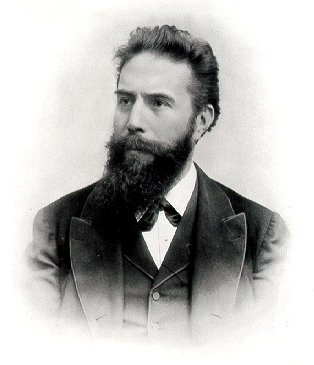| VIAS Encyclopedia provides a collection of tables and definitions commonly needed in science and engineering. |

|

Home  Science History Science History  Biographies Biographies  Wilhelm Conrad Roentgen Wilhelm Conrad Roentgen |
|||
| See also: [banner_468060_cppcourse.gif], [] | |||






|
|||
Wilhelm Conrad Roentgen (1845 - 1923)
Wilhelm Conrad Roentgen was born in the city of Lennip in the Rhineland in 1845, the son of a Dutchwoman and a German. Within three years, his family moved to the Netherlands, to the town of Apeldoorn. In 1865, subsequent to a course of study in Holland, he enrolled at the Swiss Federal Technical University in Zurich where he was taught by, amongst others, Rudolf Clausius and August Kundt. He completed his studies at the Swiss Federal Technical University in 1868, attaining his doctorate from the University of Zurich in 1869. Following this, he returned to Germany, working in Würzburg and Strasbourg. From 1875, he worked as a professor at a variety of small universities. In 1888, he accepted an assistant's position at the University of Würzburg, where he had previously worked.
In May, 1894, Roentgen wanted to repeat the experiments of Lenard regarding the presence of cathode rays in the atmosphere. For these experiments he needed thin aluminum foil which he received upon request from Lenard. The thickness of the two sheets of foil was approximately 5 µm. However, since Roentgen was selected for the role of rector of the University of Würzburg in 1894/95, this left him little time to pursue his experiments. He was only able to continue in late autumn. On the evening of November 8, 1895, he was working with a Hittorf-Crookes tube, wrapped completely in black paper. He was attempting to investigate cathode rays. A piece of barium platinum cyanide paper, which was there in order to serve as a fluorescent screen, lay at some distance from the tube. All of a sudden, the piece of paper lit up. Since the tube was completely covered with black paper, this could not have resulted from light or cathode radiation. He had discovered a new type of ray. On December 28, he wrote a report consisting of the following: "Discharge a Ruhmkorff coil into a Hittorf vacuum tube, or a sufficiently evacuated Lenard apparatus, Crookes apparatus or similar apparatus. Cover the apparatus with a fairly tight coating of thin, black cardboard. In a dark room, bring a barium platinum cyanide-treated piece of paper into close proximity to the apparatus. This paper will light up brightly once in close proximity to the tube, regardless of which way the tube is facing, whether it is the treated side or the other side". On January 23, 1896, he held a lecture for the Physical-Medical Society of Würzburg. The chronist reported: "Mr. Roentgen, welcomed by a lively and long applause, held his announced lecture on a new type of ray. Towards the end of the lecture and after the proceedings of said lecture, a photo of the silhouette of a human hand was taken, that being the hand of the honorary president of the society; Mr. von Koelliker. The latter thanked Roentgen in the name of the society for the lecture, of which he stated, they did not have anything of the same caliber within the annals of the society's minutes of meetings. He then began a round of applause for Mr. Roentgen, soon joined by the society's members and the audience, filling the auditorium three times with loud cheers and clapping. The suggestion, made by Mr. von Koelliker, to name the new X-rays; Roentgen rays, was met with a general ovation". In 1900, he overtook the role of director of the Institute for Experimental Physics, in Munich. Roentgen received the very first Nobel Prize for physics in 1901. He passed away after years of suffering, in Munich on February 10, 1923.
|
|||
Home  Science History Science History  Biographies Biographies  Wilhelm Conrad Roentgen Wilhelm Conrad Roentgen |
|||
Last Update: 2005-04-27


